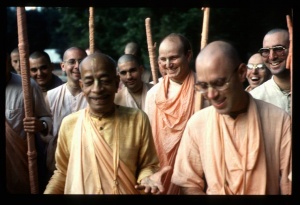CC Adi 7.83 (1975)

A.C. Bhaktivedanta Swami Prabhupada
TEXT 83
- kṛṣṇa-nāma-mahā-mantrera ei ta' svabhāva
- yei jape, tāra kṛṣṇe upajaye bhāva
SYNONYMS
kṛṣṇa-nāma—the holy name of Kṛṣṇa; mahā-mantrera—of the supreme hymn; ei ta'-this is its; svabhāva—nature; yei—anyone; jape—chants; tāra—his; kṛṣṇe—unto Kṛṣṇa; upajaye—develops; bhāva—ecstasy.
TRANSLATION
It is the nature of the Hare Kṛṣṇa mahā-mantra that anyone who chants it immediately develops his loving ecstasy for Kṛṣṇa.
PURPORT
In Bhagavad-gītā it is said:
- ahaṁ sarvasya prabhavo
- mattaḥ sarvaṁ pravartate
- iti matvā bhajante māṁ
- budhā bhāva-samanvitāḥ
"I am the source of all spiritual and material worlds. Everything emanates from Me. The wise who know this perfectly engage in My devotional service and worship Me with all their hearts." (BG 10.8) In this verse it is explained that one who chants the Hare Krsna mantra develops bhava, ecstasy, which is the point at which revelation begins. It is the preliminary stage in developing one\'s original love for God. A neophyte disciple begins by hearing and chanting, associating with devotees and practicing the regulative principles, and thus he vanquishes all of his unwanted bad habits. In this way he develops attachment for Kṛṣṇa and cannot forget Kṛṣṇa even for a moment. Bhāva is almost the successful stage of spiritual life. A sincere student aurally receives the holy name from the spiritual master, and after being initiated he follows the regulative principles given by the spiritual master. When the holy name is properly served in this way, automatically the spiritual nature of the holy name spreads; in other words, the devotee becomes qualified in offenselessly chanting the holy name. When one is completely fit to chant the holy name in this way, he is eligible to make disciples all over the world, and he actually becomes jagad-guru. Then the entire world, under his influence, begins to chant the holy names of the Hare Kṛṣṇa mahā-mantra. Thus all the disciples of such a spiritual master increase in attachment for Kṛṣṇa, and therefore he sometimes cries, sometimes laughs, sometimes dances and sometimes chants. These symptoms are very prominently manifest in the body of a pure devotee. Sometimes when our students of the Kṛṣṇa consciousness movement chant and dance, even in India people are astonished to see how these foreigners have learned to chant and dance in this ecstatic fashion. As explained by Caitanya Mahāprabhu, however, actually this is not due to practice, for without extra endeavor these symptoms become manifest in anyone who sincerely chants the Hare Kṛṣṇa mahā-mantra.
Many fools, not knowing the transcendental nature of the Hare Kṛṣṇa mahā-mantra, sometimes impede our loudly chanting this mantra, yet one who is actually advanced in the fulfillment of chanting the Hare Kṛṣṇa mahā-mantra induces others to chant also. Kṛṣṇadāsa Kavirāja Gosvāmī explains, kṛṣṇa-śakti vinā nahe tāra pravartana; unless one receives special power of attorney from the Supreme Personality of Godhead, he cannot preach the glories of the Hare Kṛṣṇa mahā-mantra. As devotees propagate the Hare Kṛṣṇa mahā-mantra, the general population of the entire world gets the opportunity to understand the glories of the holy name. While chanting and dancing or hearing the holy name of the Lord, one automatically remembers the Supreme Personality of Godhead, and because there is no difference between the holy name and Kṛṣṇa, the chanter is immediately linked with Kṛṣṇa. Thus connected, a devotee develops his original attitude of service to the Lord. In this attitude of constantly serving Kṛṣṇa, which is called bhāva, he always thinks of Kṛṣṇa in many different ways. One who has attained this bhāva stage is no longer under the clutches of the illusory energy. When other spiritual ingredients, such as trembling, perspiration and tears, are added to this bhāva stage, the devotee gradually attains love of Kṛṣṇa.
The holy name of Kṛṣṇa is called the mahā-mantra. Other mantras mentioned in the Nārada-pañcarātra are known simply as mantras, but the chanting of the holy name of the Lord is called the mahā-mantra.